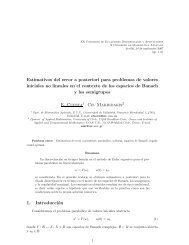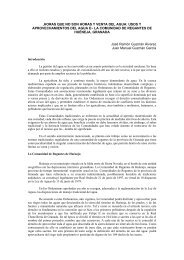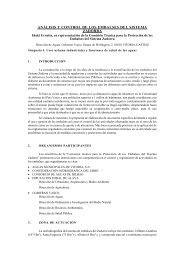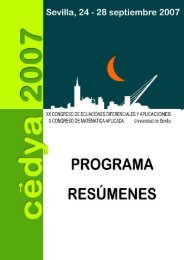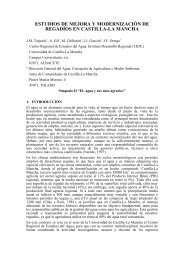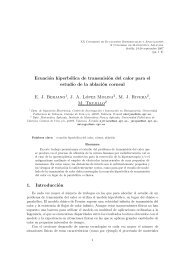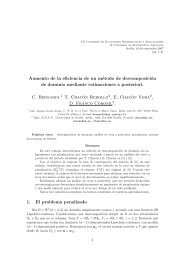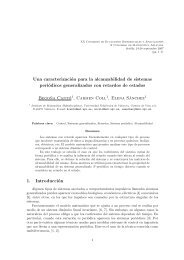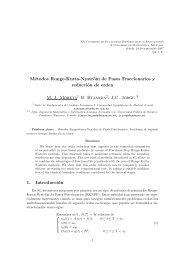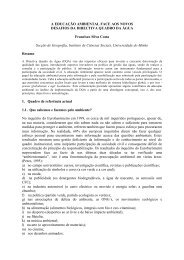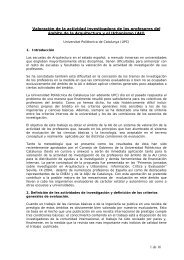Libro de resúmenes y programa(definitivo) - Universidad de Sevilla
Libro de resúmenes y programa(definitivo) - Universidad de Sevilla
Libro de resúmenes y programa(definitivo) - Universidad de Sevilla
You also want an ePaper? Increase the reach of your titles
YUMPU automatically turns print PDFs into web optimized ePapers that Google loves.
Fenómenos <strong>de</strong> transporte a todas<br />
las escalas<br />
Quinto encuentro <strong>de</strong> la red española <strong>de</strong> física <strong>de</strong> sistemas fuera <strong>de</strong>l<br />
equilibrio
PROGRAMA:<br />
Hora Miércoles 7<br />
9:30-10:00 RECEPCIÓN<br />
10:00-10:40 CAFÉ<br />
10:40-11:30 MARINI<br />
11:30-12:10 GARCIMARTIN<br />
12:10-12:50 DOMINGUEZ<br />
13:00-15:00 COMIDA<br />
15:00-15:50 KURCHAN<br />
15:50-16:30 VEGA<br />
16:30-17:00 CAFÉ<br />
17:00-17:40 PUERTAS<br />
17:40-18:20 SANCHEZ<br />
Hora Jueves 8 Viernes 9<br />
9:30-10:20 VAN ROIJ VAN DER MEER<br />
10:20-10:50 CAFÉ CAFÉ<br />
10:50-11:30 SCAGLIARINI HURTADO<br />
11:30-12:10 PLATERO HITA<br />
12:10-12:50 PRADOS ABAD<br />
13:00-15:00 COMIDA COMIDA<br />
15:00-15:40 VILAR<br />
15:40-16:20 RUIZ-MONTERO<br />
16:20-17:00 CEBRIÁN<br />
17:00-17:30 CAFÉ<br />
21:00 CENA<br />
La cena será en el restaurante Porta Rossa en la Calle Arenal 5.
Acceso Wi-Fi:<br />
Red: ReInUS<br />
Usuario: re<strong>de</strong>spfe5<br />
Password: sev79mar&
Resúmenes
Diffusion and reactions in biologically motivated problems<br />
E. Abad<br />
Centro Universitario <strong>de</strong> Mérida, Avda. Santa Teresa <strong>de</strong> Jornet, 38, E-06080 Mérida<br />
S. B. Yuste<br />
Dpto. <strong>de</strong> Física, <strong>Universidad</strong> <strong>de</strong> Extremadura, Av. Elvas s/n, 06071 Badajoz<br />
K. Lin<strong>de</strong>nberg<br />
Department of Chemistry and Biochemistry, and BioCircuits Institute, University of CaliforniaSan<br />
Diego, 9500 Gilman Drive, La Jolla, California 92093-0340, USA<br />
In this contribution we review some recent results from stochastic mo<strong>de</strong>ls for transport properties<br />
in three biologically motivated problems. The first problem concerns the calculation of<br />
conductance properties of ion channels via a master equation approach. We study the case of<br />
a narrow channel with monoionic conduction and set up a 1D rate mo<strong>de</strong>l where ions overcome<br />
large energy barriers by hopping between neighbouring energy minima. We compute the hopping<br />
rates in terms of first passage times and splitting probabilities for the un<strong>de</strong>rlying generalized<br />
Kramers problem [1]. Within this framework we are able to compute conductance properties for<br />
the gramicidin A channel in terms of a single adjustable parameter (the equilibrium ion entry rate).<br />
We obtain good fits to experimental curves by tuning this parameter within a physiologically acceptable<br />
range. Next, we consi<strong>de</strong>r transport in a ratchet mo<strong>de</strong>l providing an i<strong>de</strong>alized <strong>de</strong>scription<br />
of the motion of motor proteins along microtubuli. More specifically, we study the overdamped<br />
motion of a Brownian particle in a 1D periodic potential whose amplitu<strong>de</strong> fluctuates between two<br />
states un<strong>de</strong>r the action of coloured noise [2]. The latter aims to mimic memory effects arising<br />
from ATP hydrolysis -the driving force responsible for the protein motion along the microtubule-.<br />
We compute the particle flux as a function of temperature and the autocorrelation time of the<br />
coloured noise. We find that the results are very sensitive to the specific <strong>de</strong>tails of the potential<br />
geometry, and in many cases we observe flux reversals when varying the typical system parameters<br />
Finally, we address the problem of morphogen gradient formation by extending the classical<br />
1D synthesis-diffusion-<strong>de</strong>gradation (SSD) mo<strong>de</strong>l to account for the possibility of anomalous subdiffusion<br />
[3]. The resulting reaction-subdiffusion equation contains a Riemann-Liouville fractional<br />
<strong>de</strong>rivative which accounts for memory effects arising from anomalous transport. When solved using<br />
the proper boundary conditions, our equation gives morphogen concentration profiles which<br />
strongly differ from those yiel<strong>de</strong>d by the SSD mo<strong>de</strong>l. We discuss the possible relevance of the<br />
above results for biological systems.<br />
[1] E.Abad, J. Reingruber, and M.S.P. Sansom, On a novel rate theory for transport in narrow<br />
ion channels and its application to flux optimization via geometric effects, J. Chem. Phys. 130,<br />
085101 (2009).<br />
[2] E. Abad and A. Mielke, Brownian motion in periodic fluctuating potentials, Ann. Physik 7<br />
(1998), 9-23.<br />
[3] S.B. Yuste, E. Abad and K. Lin<strong>de</strong>nberg, Reaction-subdiffusion mo<strong>de</strong>l for morphogen gradient<br />
formation, Phys. Rev. E 82, 061123 (2010).
Resolución <strong>de</strong> la ecuación cinética en superre<strong>de</strong>s semiconductoras<br />
mediante métodos <strong>de</strong> partículas y diferencias finitas.<br />
Elena Cebrian<br />
Departamento <strong>de</strong> Matemáticas y Computación. <strong>Universidad</strong> <strong>de</strong> Burgos.<br />
Mariano Alvaro, Manuel Carretero y Luis L.Bonilla<br />
G. Millán Institute of Fluid Dynamics, Nanosciencce and Industrial Mathematics, <strong>Universidad</strong> Carlos<br />
III <strong>de</strong> Madrid, Avenida <strong>de</strong> la <strong>Universidad</strong> 30, 28911 Leganés<br />
Las superre<strong>de</strong>s semiconductoras son cristales artificiales unidimensionales formados por crecimiento<br />
epitaxial <strong>de</strong> capas pertenecientes a semiconductores diferentes [4]. Fueron i<strong>de</strong>adas por<br />
Esaki y Tsu [6] para obtener oscilaciones <strong>de</strong> Bloch. La banda <strong>de</strong> conducción <strong>de</strong> la superred es<br />
una sucesión periódica <strong>de</strong> barreras y pozos. Cuando se aplica una diferencia <strong>de</strong> potencial entre<br />
los contactos, es posible obtener oscilaciones estables <strong>de</strong> la corriente [4], causadas por pulsos<br />
<strong>de</strong>l campo eléctrico originados en el cátodo que se mueven hasta <strong>de</strong>saparecer por ánodo y son<br />
similares a las <strong>de</strong>l efecto Gunn (GHz) aunque diferentes a las <strong>de</strong> Bloch (THz) [7]. Las oscilaciones<br />
tipo Gunn han sido observadas en experimentos con superre<strong>de</strong>s GaAs/AlAs <strong>de</strong>s<strong>de</strong> 1996<br />
y son la base <strong>de</strong> los dispositivos con oscilaciones rápidas.<br />
El transporte <strong>de</strong> electrones en una minibanda <strong>de</strong> la superred pue<strong>de</strong> ser <strong>de</strong>scrito por una<br />
ecuación cinética acoplada a la ecuación <strong>de</strong> Poisson [3]. El operador <strong>de</strong> colisión pue<strong>de</strong> ser simplificado<br />
mediante un término tipo Bhatnagar-Gross-Krook (BGK) [2]. La relación <strong>de</strong> dispersión<br />
entre las minibandas <strong>de</strong> energía y los momentos es periódica <strong>de</strong>bido a la relación entre la velocidad<br />
<strong>de</strong> difusión <strong>de</strong> los electrones y el campo eléctrico, el cual tiene un valor máximo [4]. Entonces<br />
la velocidad <strong>de</strong> difusión <strong>de</strong>crece cuando el campo crece para valores gran<strong>de</strong>s <strong>de</strong>l campo<br />
(movilidad diferencial negativa). Esto da lugar a las oscilaciones autosostenidas tipo Gunn <strong>de</strong> la<br />
corriente cuando se toman condiciones <strong>de</strong> contorno apropiadas [4].<br />
Bonilla y otros [1,3] han <strong>de</strong>rivado la ecuación <strong>de</strong> convección-difusión no lineal <strong>de</strong>l campo<br />
eléctrico a partir <strong>de</strong>l mo<strong>de</strong>lo cinético acoplado a la ecuación <strong>de</strong> Poisson con término <strong>de</strong> colisión<br />
tipo BGK, usando un método perturbativo tipo Chapman Enskog en el límite hiperbólico en el cual<br />
el operador <strong>de</strong> colisión es <strong>de</strong>l mismo or<strong>de</strong>n que el término que contiene al campo eléctrico y domina<br />
al resto <strong>de</strong> los términos. Entonces las oscilaciones autosostenidas <strong>de</strong> la corriente se obtienen<br />
resolviendo numéricamente las ecuaciones <strong>de</strong> convección-difusión con condiciones <strong>de</strong> contorno<br />
apropiadas. En esta presentación se muestra cómo se ha abordado la resoluci’on numérica <strong>de</strong>l<br />
mo<strong>de</strong>lo cinético semiclásico usando por un lado el método <strong>de</strong> partículas pon<strong>de</strong>rado [5] y por otro<br />
un método <strong>de</strong> diferencias finitas. Con ambos métodos se han obtenido prácticamente los mismos<br />
resultados, los cuales son muy similares a los obtenidos con la ecuación hidrodin’amica.<br />
[1] M. Alvaro, M. Carretero, L. L. Bonilla. Numerical method for hydrodynamic modulation<br />
equations <strong>de</strong>scribing Bloch oscillations in semiconductor superlattices (prepint).<br />
[2] P.L. Bhatnagar, E.P. Gross, M. Krook, Phys. Rev. 94 (1954) 511-525.<br />
[3] L.L. Bonilla, R. Escobedo, A. Perales, Phys. Rev. B 68 (2003) 241304(R) (4 pages).<br />
[4] L.L. Bonilla, H.T. Grahn, Rep. Prog. Phys. 68 (2005) 577-683.<br />
[5] E. Cebrin, L.L.Bonilla and A.Carpio, J. Comput. Phys. (228), 7689-7705 (2009).<br />
[6] L. Esaki and R. Tsu, IBM J. Res. Develop. 14, 61-65 (1970).<br />
[7] H. Kroemer, Pages 20-98. John Wiley, N. Y. 1972.
From gravitational colapse to spinodal <strong>de</strong>composition<br />
Alvaro Domínguez<br />
Física Teórica, <strong>Universidad</strong> <strong>de</strong> <strong>Sevilla</strong>, Apdo. <strong>de</strong> Correos 1065, <strong>Sevilla</strong> 41080, Spain<br />
Colloidal monolayers (colloidal particles trapped at the interface between two fluids) are a<br />
faithful experimental realization of a two-dimensional fluid, for which reason they have attracted<br />
much interest during the last years. The interaction between particles un<strong>de</strong>r generic conditions<br />
can be dominated by the capillary forces due to the <strong>de</strong>formation of the fluid interface. The large<br />
difference between the effective interaction range (∼millimeters) and the typical interparticle separation<br />
(∼micrometers) is particularly interesting. Together with the <strong>de</strong>pen<strong>de</strong>nce of the capillary<br />
force on separation, this characteristic confers the system features of both a self–gravitating fluid<br />
as well as of a van <strong>de</strong>r Waals fluid.<br />
We have studied a mean-field dynamical mo<strong>de</strong>l for this system. We present the results of theoretical<br />
calculations and N-body simulations for the instability of an initially homogeneous particle<br />
distribution, paying special attention to the crossover of the evolution from “gravitational collapse”<br />
to “spinodal <strong>de</strong>composition”.
Reducción <strong>de</strong> atascos mediante obstáculos.<br />
Angel Garcimartín, Iker Zuriguel y Alvaro Janda<br />
Departamento <strong>de</strong> Física y Matemática Aplicada Facultad <strong>de</strong> Ciencias <strong>Universidad</strong> <strong>de</strong> Navarra<br />
31080 Pamplona, Spain<br />
Presentamos resultados experimentales sobre el efecto que provoca un obstáculo colocado<br />
justo antes <strong>de</strong> la salida <strong>de</strong> un silo. Si la posición <strong>de</strong> este obstáculo es la a<strong>de</strong>cuada, hemos<br />
encontrado que se pue<strong>de</strong> reducir la probabilidad <strong>de</strong> atasco en un factor 100. Sorpren<strong>de</strong>ntemente,<br />
el flujo medio no varía apreciablemente. Por mediciones indirectas po<strong>de</strong>mos concluir que la causa<br />
<strong>de</strong> este fenómeno es la reduccin <strong>de</strong> la presin en la zona que queda entre el orificio <strong>de</strong> salida y el<br />
obstáculo (figura). Tambin se presentará un experimento en ciernes para probar si este mismo<br />
método es eficaz con seres vivos.<br />
[1] I. Zuriguel, A. Janda, A. Garcimartín, C. Lozano, R. Arévalo and D. Maza, Silo Clogging<br />
Reduction by the Presence of an Obstacle, Phys. Rev. Lett. 107 (2011), 278001.
Correlaciones espaciales en problemas <strong>de</strong> reacción-difusión<br />
con el algoritmo <strong>de</strong> Gillespie<br />
Jorge Luis Hita y José M. Ortiz <strong>de</strong> Zárate<br />
<strong>Universidad</strong> Complutense<br />
Recientemente hemos iniciado un <strong>programa</strong> para simular, utilizando el algoritmo <strong>de</strong> Gillespie,<br />
problemas <strong>de</strong> reacción-difusión isotermos en una dimensión espacial. Preten<strong>de</strong>mos estudiar<br />
numéricamente las correlaciones estadísticas <strong>de</strong> las fluctuaciones <strong>de</strong> la concentración en<br />
distintos puntos espaciales; con el objetivo último <strong>de</strong> verificar que son <strong>de</strong> corto alcance si las<br />
reacciones químicas (procesos cinéticos) estn en equilibrio y que son <strong>de</strong> largo alcance si las<br />
reacciones químicas están fuera <strong>de</strong>l equilibrio.<br />
Presentaremos algunos <strong>de</strong> los resultados más relevantes que hemos obtenido hasta ahora.<br />
Primero en sistemas homogéneos (sin difusión y, por consiguiente, con concentración espacialmente<br />
uniforme) estudiaremos el número <strong>de</strong> partículas N necesarias para que la distribución <strong>de</strong><br />
probabilidad <strong>de</strong> las fluctuaciones en la concentración, <strong>de</strong>bidas al carácter estocstico <strong>de</strong>l proceso<br />
cinético, pueda consi<strong>de</strong>rarse gaussiana. Una convergencia óptima a una gaussiana se consigue<br />
con pocos cientos <strong>de</strong> partículas, como se <strong>de</strong>muestra con un test <strong>de</strong> percentiles. La varianza σ<br />
obtenida <strong>de</strong> estas simulaciones coinci<strong>de</strong> con las predicciones <strong>de</strong> la system-size expansion <strong>de</strong><br />
van Kampen.<br />
También presentaremos resultados obtenidos <strong>de</strong> simular la difusión (1D) con una adaptación<br />
<strong>de</strong>l algoritmo <strong>de</strong> Gillespie recientemente propuesta para este fin. Como era <strong>de</strong> esperar, las<br />
distribuciones <strong>de</strong> probabilidad <strong>de</strong> las fluctuaciones son gaussianas con varianza dada por la raíz<br />
cuadrada <strong>de</strong>l número medio <strong>de</strong> partículas por sitio. El siguiente paso será combinar difusión y<br />
reacciones químicas.
Spontaneous Symmetry Breaking at the Fluctuating Level<br />
Pablo I. Hurtado and Pedro L. Garrido<br />
Departamento <strong>de</strong> Electromagnetismo y Física <strong>de</strong> la Materia, and Instituto Carlos I <strong>de</strong> Física<br />
Teórica y Computacional, <strong>Universidad</strong> <strong>de</strong> Granada, Granada 18071, Spain<br />
Phase transitions not allowed in equilibrium steady states may happen however at the fluctuating<br />
level. We observe for the first time this striking and general phenomenon measuring<br />
current fluctuations in an isolated diffusive system. While small fluctuations result from the sum<br />
of weakly-correlated local events, for currents above a critical threshold the system self-organizes<br />
into a coherent traveling wave which facilitates the current <strong>de</strong>viation by gathering energy in a localized<br />
packet, thus breaking translation invariance. This results in Gaussian statistics for small<br />
fluctuations but non-Gaussian tails above the critical current. Our observations, which agree with<br />
predictions <strong>de</strong>rived from hydrodynamic fluctuation theory, strongly suggest that rare events are<br />
generically associated with coherent, self-organized patterns which enhance their probability.<br />
[1] P.I. Hurtado and P.L. Garrido, Phys. Rev. Lett. 107, 180601 (2011).
Inequalities that generalize the second law.<br />
Jorge Kurchan<br />
CNRS, Francia<br />
Some fifteen years ago, Jarzynski proved a very general and elementary equality, form which<br />
a form of the Second Principle follows immediately. More recently, Hatano and Sasa showed that<br />
one may generalize this to systems whose dynamics is by construction non-equilibrium even in<br />
the stationary regime; such as, for example, a bar with a potential difference at the ends. The<br />
problem with this generalization of the Second Law is that it requires the precise knowledge of the<br />
probability distribution in every stationary nonequilibrium configuration, and, more seriously, that<br />
the inequality obtained may be in some cases empty. We have been studying alternative versions<br />
of the Second Law, which may potentially be used in most cases, and which in addition suggest a<br />
variational principle for the distribution function.
Dynamics of Fluids in Nanospaces<br />
Umberto Marini Bettolo Marconi, Camerino<br />
In this contribution we review some recent results from stochastic mo<strong>de</strong>ls for transport properties<br />
in three biologically motivated problems. The first problem concerns the calculation of<br />
conductance properties of ion channels via a master equation approach. We study the case of<br />
a narrow channel with monoionic conduction and set up a 1D rate mo<strong>de</strong>l where ions overcome<br />
large energy barriers by hopping between neighbouring energy minima. We compute the hopping<br />
rates in terms of first passage times and splitting probabilities for the un<strong>de</strong>rlying generalized<br />
Kramers problem [1]. Within this framework we are able to compute conductance properties for<br />
the gramicidin A channel in terms of a single adjustable parameter (the equilibrium ion entry rate).<br />
We obtain good fits to experimental curves by tuning this parameter within a physiologically acceptable<br />
range. Next, we consi<strong>de</strong>r transport in a ratchet mo<strong>de</strong>l providing an i<strong>de</strong>alized <strong>de</strong>scription<br />
of the motion of motor proteins along microtubuli. More specifically, we study the overdamped<br />
motion of a Brownian particle in a 1D periodic potential whose amplitu<strong>de</strong> fluctuates between two<br />
states un<strong>de</strong>r the action of coloured noise [2]. The latter aims to mimic memory effects arising<br />
from ATP hydrolysis -the driving force responsible for the protein motion along the microtubule-.<br />
We compute the particle flux as a function of temperature and the autocorrelation time of the<br />
coloured noise. We find that the results are very sensitive to the specific <strong>de</strong>tails of the potential<br />
geometry, and in many cases we observe flux reversals when varying the typical system parameters<br />
Finally, we address the problem of morphogen gradient formation by extending the classical<br />
1D synthesis-diffusion-<strong>de</strong>gradation (SSD) mo<strong>de</strong>l to account for the possibility of anomalous subdiffusion<br />
[3]. The resulting reaction-subdiffusion equation contains a Riemann-Liouville fractional<br />
<strong>de</strong>rivative which accounts for memory effects arising from anomalous transport. When solved using<br />
the proper boundary conditions, our equation gives morphogen concentration profiles which<br />
strongly differ from those yiel<strong>de</strong>d by the SSD mo<strong>de</strong>l. We discuss the possible relevance of the<br />
above results for biological systems. References [1] E.Abad, J. Reingruber, and M.S.P. Sansom,<br />
On a novel rate theory for transport in narrow ion channels and its application to flux optimization<br />
via geometric effects, J. Chem. Phys. 130, 085101 (2009). [2] E. Abad and A. Mielke, Brownian<br />
motion in periodic fluctuating potentials, Ann. Physik 7 (1998), 9-23. [3] S.B. Yuste, E. Abad and<br />
K. Lin<strong>de</strong>nberg, Reaction-subdiffusion mo<strong>de</strong>l for morphogen gradient formation, Phys. Rev. E 82,<br />
061123 (2010).
Coherent dynamics of electrons in ac driven quantum dot arrays<br />
G. Platero<br />
Instituto <strong>de</strong> Ciencia <strong>de</strong> Materiales (CSIC) Cantoblanco , Madrid , Spain.<br />
A powerful method of manipulating the coherent dynamics of quantum particles is to control<br />
the phase of their tunnelling. We will show how such phases can be produced in two distinct and<br />
complementary ways. We have consi<strong>de</strong>red the dynamics of two interacting electrons hopping on<br />
a quasi onedimensional lattice with a nontrivial topology, threa<strong>de</strong>d by a uniform magnetic flux, and<br />
study the effect of adding a time periodic ac electric field. We will show that the dynamical phases<br />
produced by the driving field can combine with the familiar AharonovBohm phases arising from<br />
the magnetic flux to give precise control over the dynamics and localization of the particles, even<br />
in the presence of strong particle interactions [1]. Recent electron spin resonance experiments<br />
measure coherent spin rotations of one single electron, a fundamental ingredient for quantum<br />
operations. We will show how it is possible to manipulate electron charge and spin dynamics in<br />
double and triple quantum dots by means of ac magnetic fields. We <strong>de</strong>monstrate that by tuning<br />
the the field intensity, frequency and the phase difference between the fields within each dot,<br />
charge localization can be achieved. Furthermore, ac magnetic fields are also able to induce spin<br />
locking, i.e., to freeze the electronic spin, at certain field parameters and symmetry configurations<br />
[2]. Spin Blocka<strong>de</strong> has been measured in transport experiments through double quantum dots.<br />
We will discuss the effect of ac magnetic fields on spin blocka<strong>de</strong> and we will show that ac magnetic<br />
fields can not only remove spin blocka<strong>de</strong> , but also restore it due to collective rotations of the<br />
two spins. at certain parameters of the field [3].<br />
[1] C.E. Creffield and G. Platero, Phys. Rev. Lett. 105, 086804 (2010).<br />
[2] A. Gómez-León and G. Platero, Phys. Rev. B, 84, 121310(R) (2011).<br />
[3] M. Busl et al., Phys. Rev. B, 81, 121306(R) (2010); R. Sánchez et al., Phys. Rev. B ,77,<br />
165312 (2008).
Large Fluctuations in Driven Dissipative Media<br />
A. Prados and A. Lasanta<br />
Física Teórica, <strong>Universidad</strong> <strong>de</strong> <strong>Sevilla</strong>, Apdo. <strong>de</strong> Correos 1065, <strong>Sevilla</strong> 41080, Spain<br />
Pablo I. Hurtado<br />
Instituto Carlos I <strong>de</strong> Física Teórica y Computacional, <strong>Universidad</strong> <strong>de</strong> Granada, Granada 18071,<br />
Spain<br />
We analyze the fluctuations of the dissipated energy in a simple and general mo<strong>de</strong>l where<br />
dissipation, diffusion and driving are the key ingredients. The full dissipation distribution, which<br />
follows from hydrodynamic fluctuation theory, shows non-Gaussian tails and no negative branch,<br />
thus violating the fluctuation theorem as expected from the irreversibility of the dynamics. It exhibits<br />
simple scaling forms in the weak- and strong-dissipation limits, with large fluctuations favored<br />
in the former case but strongly suppressed in the latter. The typical path associated to a<br />
given dissipation fluctuation is also analyzed in <strong>de</strong>tail. Our results, confirmed in extensive simulations,<br />
strongly support the validity of hydrodynamic fluctuation theory to <strong>de</strong>scribe fluctuating<br />
behavior in driven dissipative media.<br />
[1] A. Prados, A. Lasanta and P. I. Hurtado, Phys. Rev. Lett. 107, 140601 (2011)
Comparison of different forcings in active microheology<br />
in colloids<br />
Antonio M. Puertas<br />
Group of Complex Fluids Physics, Departamento <strong>de</strong> Fısica Aplicada<br />
<strong>Universidad</strong> <strong>de</strong> Almería, 04120 Almería (SPAIN)<br />
Whereas pasive microrheology in colloids is based solely on the observation of single particle<br />
motion, in active microrheology, colloidal tracers experience external forces and their behaviour<br />
is observed. In both cases, the complex microscopic mechanical behaviour is measured and a<br />
connection with bulk quantities is usually sought. I will present here simulations of active microrhelogy<br />
in a <strong>de</strong>nse system of hard colloids where one particle is dragged through the system. The<br />
tracer is dragged i) with a constant external force, (the velocity fluctuates) ii) at a constant speed<br />
(with a fluctuating force) or iii) held in a harmonic trap moving at constant speed. The friction<br />
coefficient is measured using the linear relationship between the (average) drag force and the<br />
(average) velocity, in the stationary regime. Different results are obtained in the three different<br />
cases, providing distinct aspects of the microscopic dynamics of the system. Larger friction coefficients<br />
are measured at constant velocity as the tracer must open its way through the system,<br />
and agree with the case of the harmonic trap at low velocities. On the other hand, small friction<br />
coefficients are obtained when the particle is dragged at a constant force, and agree with the<br />
harmonic trap at large velocities. Interestingly, a yield ”stress” is observed in the constant force<br />
case, giving an estimate of the strength of the cage of neighbours. In all cases, comparison is<br />
ma<strong>de</strong> with theoretical results based on a low <strong>de</strong>nsity theory [Phys. Fluids 17, 073101 (2005)].
Temperature anisotropy in granular fluids<br />
Maria J. Ruiz-Montero and J. Javier Brey<br />
Física Teórica. <strong>Universidad</strong> <strong>de</strong> <strong>Sevilla</strong><br />
One of the consequences of inelasticity in granular mixtures is that the energy equipartition<br />
required in equilibrium systems is not verified. The granular temperatures of the components of<br />
the mixture, <strong>de</strong>fined from the average kinetic energy of each species are not equal. This feature<br />
was pointed out many years ago [1], and a systematic study of it has been carried out in the last<br />
years.<br />
Once established that the partial temperatures are different, some questions arise: should they<br />
be incorporated to the set of variables nee<strong>de</strong>d to i<strong>de</strong>ntify the macroscopic state of the mixture? If<br />
the answer is negative, are the partial temperatures <strong>de</strong>termined by the usual set of hydrodynamic<br />
fields and the properties of the particles? In this work we will study the steady state of a vibrated<br />
granular mixture in the presence of gravity in the low <strong>de</strong>nsity limit, and we will show that the<br />
macroscopic state in the bulk of the system is <strong>de</strong>fined by intensive variables that do not inclu<strong>de</strong><br />
the partial temperatures of the system. Also, the local cooling rates of each of the components<br />
will be investigated, and the accuracy of the expression obtained assuming a local homogeneous<br />
cooling state distribution [2] of the gas will be analyzed by comparing it with computer simulations<br />
of the system.<br />
[1] J.T. Jenkins and F. Mancini, J. Appl. Mech. Vol. 35, 27 (1987).<br />
[2] V. Garzo and J.W. Dufty, Phys. Rev. E Vol. 60, 5706 (1999).
Asymmetric thermopower in mesoscopic transport<br />
David Sánchez and Llorenç Serra<br />
Institut <strong>de</strong> Física Interdisciplinar i <strong>de</strong> Sistemes Complexos IFISC (CSIC-UIB), E-07122 Palma <strong>de</strong><br />
Mallorca, Spain.<br />
Departament <strong>de</strong> Física, Universitat <strong>de</strong> les Illes Balears, E-07122 Palma <strong>de</strong> Mallorca, Spain<br />
We consi<strong>de</strong>r a generic quantum conductor coupled to two electric terminals. Phase-coherent<br />
transport is generated across the conductor when an electric or thermal gradient is applied to the<br />
reservoirs. We investigate heat and charge transport un<strong>de</strong>r the influence of inelastic processes,<br />
which are mo<strong>de</strong>led using an additional reservoir acting as an i<strong>de</strong>al volgate and thermal probe.<br />
We illustrate our method with an application to a ballistic chaotic cavity. We find within random<br />
matrix theory that thermopower fluctuations disappear quickly as the probe mo<strong>de</strong> number<br />
increases [1].<br />
Importantly, we find that, upon elimination of the probe, the two-terminal Seebeck coefficient<br />
shows an asymmetry when an applied magnetic field reverses its direction. This asymmetry effect<br />
is revealed in the presence of incoherent scattering only. Furthermore, the asymmetry effect is of<br />
higher or<strong>de</strong>r in a Sommerfeld expansion [1]. We believe that our results are relevant to quantify<br />
the efficiency of thermoelectric nano<strong>de</strong>vices in the presence of <strong>de</strong>phasing.<br />
[1] D. Sánchez and Ll. Serra, Phys. Rev. B 84, 201307(R) (2011).
Self-assembly and flocking in active colloidal suspensions<br />
Andrea Scagliarini and Ignacio Pagonabarraga<br />
Departament <strong>de</strong> Física Fonamental Universitat <strong>de</strong> Barcelona<br />
Active fluids, such as suspensions of self-propelled particles or of cytoskeletal filaments and<br />
molecular motors, are a fascinating example of soft matter displaying non-trivial collective behaviours<br />
which representing issues in non-equilibrium statistical physics [1].<br />
Moreover, the recent <strong>de</strong>velopment of techniques to assemble miniaturized <strong>de</strong>vices has led to<br />
an ever-growing interest for micro- and nano- scale engines that can perform autonomous motion<br />
[2] (”microrobots”), as, for instance, self-phoretic colloids, for which the propulsion is induced<br />
by the generation of a chemical species in a reaction (locally) catalyzed at the particle surface<br />
[3,4]. In our simulations colloids are <strong>de</strong>scribed as resolved finite size particles, interacting with a<br />
concentration field according to a coarse-grained mo<strong>de</strong>l [5].<br />
We have tested the numerical implementation against exact results on the chemotactic behaviour<br />
of an isolated particle as well as on the self-propulsion mechanism. Our study on suspensions<br />
of several particles suggests the existence of a non-equilibrium transition from a flocking<br />
state to the formation of fractal-like aggregates, at changing a parameter accounting for the<br />
particle-”fuel” chemical affinity [6].<br />
[1] S. Ramaswamy, Annu. Rev. Con<strong>de</strong>s. Matter Phys. 1, 323 (2010).<br />
[2] R. Dreyfus et al, Nature 437, 862 (2005).<br />
[3] W.E. Paxton et al, J. Am. Chem. Soc. 126, 13424 (2004).<br />
[4] J.R. Howse et al, Phys. Rev. Lett. 99, 048102 (2007).<br />
[5] R. Golestanian et al, Phys. Rev. Lett. 94, 220801 (2005).<br />
[6] A. Scagliarini and I. Pagonabarraga, in preparation (2012).
Harvesting ”blue” energy by reversibly mixing river- and sea<br />
water.<br />
René van Roij<br />
Utrecht University, Holanda<br />
The mixing of fresh river water and salty sea water is an irreversible process, in which about<br />
2 kJ of (free) energy is dissipated with every liter of river water that flows into the sea, i.e. the<br />
equivalent of a waterfall of 200m. In this talk we will discuss how this energy can be harvested.<br />
After a general introduction we will focus on Brogioli’s recently <strong>de</strong>veloped capacitive <strong>de</strong>vice [1],<br />
which cyclicly charges and discharges nanoporous electro<strong>de</strong>s immersed in sea- and river water,<br />
respectively, such that the expansion and compression of the electrostatic double layer in fresh<br />
and salty water is exploited. We will show that Brogioli’s <strong>de</strong>vice can be seen as an analogue of a<br />
Stirling heat engine, and we propose a modification to construct the most efficient ”blue engine”<br />
based on a Carnot-like cycle [2]. The blue engine running in reverse-mo<strong>de</strong> is a <strong>de</strong>salination <strong>de</strong>vice,<br />
yielding separated fresh and salty water from brackish water at the expense of energy input;<br />
the heat-engine analogue is a fridge [2]. Interestingly, the potential of the porous electro<strong>de</strong>s in the<br />
<strong>de</strong>vice are as high as 500mV, exceeding the thermal voltage ( 25mV) by far, such that ordinary<br />
Poisson-Boltzmann (PB) theory breaks down, even for monovalent ions in water. The Stern layer<br />
and other ion-specific effects become relevant in this regime. We will discuss an extension of PB<br />
theory in which the ”polarisability holes” due to the poorly polarisable ions compared to water are<br />
taken into account, giving good agreement with experimental measurements of differential capacities<br />
[3].<br />
[1] D. Brogioli, Phys. Rev. Lett. 103, 058501 (2009).<br />
[2] N. Boon and R. van Roij, Mol. Phys. 109, 1229 (2011).<br />
[3] M. Hatlo, R. van Roij and L. Lue, Europhys. Lett. 97, 28010 (2012).
A granular ratchet: Spontaneous symmetry breaking and<br />
fluctuation theorems in a granular gas<br />
Devaraj van <strong>de</strong>r Meer, Peter Eshuis, Sylvain Joubaud, Ko van <strong>de</strong>r Weele and Detlef Lohse.<br />
Physics of Fluids group, University of Twente, The Netherlands.<br />
We construct a ratchet of the Smoluchowski-Feynman type, consisting of four vanes that are<br />
allowed to rotate freely in a vibrofluidized granular gas. The necessary out-of-equilibrium environment<br />
is provi<strong>de</strong>d by the inelastically colliding grains, and the equally crucial symmetry breaking<br />
by applying a soft coating to one si<strong>de</strong> of each vane. The onset of the ratchet effect occurs at a<br />
critical shaking strength via a smooth, continuous phase transition. For very strong shaking the<br />
vanes interact actively with the gas and a convection roll <strong>de</strong>velops, sustaining the rotation of the<br />
vanes. From the experimental results we show that a steady state fluctuation relation holds for<br />
the work injected to the system, and that its entropy production satisfies a <strong>de</strong>tailed fluctuation theorem.<br />
Surprisingly, we find that the above relations are satisfied even when a convection roll has<br />
<strong>de</strong>veloped and there exists a strong coupling between the motion of the vanes and the granular<br />
gas.
Properties of the segregation of a granular impurity un<strong>de</strong>r<br />
Couette-Fourier flows<br />
Francisco Vega Reyes, Vicente Garzó, Andrés Santos<br />
Departamento <strong>de</strong> Física, <strong>Universidad</strong> <strong>de</strong> Extremadura, E-06071 Badajoz. Spain<br />
We study in this work the segregation of a granular impurity un<strong>de</strong>r Couette-Fourier flow. Our<br />
system consists of two sets (1,2) composed of i<strong>de</strong>ntical inelastic hard spheres with low <strong>de</strong>nsity,<br />
each set being characterized by different size and mass. We also consi<strong>de</strong>r that each type of<br />
binary collisions (1-1, 1-2, 2-2 particle collisions) is characterized by a different <strong>de</strong>gree of inelasticity.<br />
One of the sets is present in an almost negligible concentration compared to the other<br />
set, and thus it can be consi<strong>de</strong>red as an ’impurity’ and the tracer limit for this species applies<br />
[1]. Our granular spheres are enclosed between two infinite parallel walls that act as shear and<br />
temperature sources. We consi<strong>de</strong>r that in general both walls are at different temperatures. We<br />
obtain an exact numerical solution of the corresponding inelastic Boltzmann-Lorentz equation for<br />
the granular impurity in this system (using the direct simulation Monte Carlo method, DSMC). Recently,<br />
special cases of granular Couette-Fourier flows for a monocomponent granular gas have<br />
been <strong>de</strong>scribed in the same geometry. They may be called LTy and LTu classes because they<br />
have linear temperature profiles: the first one, is linear vs. the space coordinate [2] whereas the<br />
LTu class has a linear profile vs. flow velocity, and is also characterized by a constant heat flux<br />
throughout the system [2]. We show that both special classes of flows also exist for the granular<br />
impurity, with the same aforementioned properties. Moreover, we show that an impurity un<strong>de</strong>r LTy<br />
and LTu Couette-Fourier flows, shows also the following hydrodynamic properties: 1) no diffusion<br />
with respect to the granular gas (i.e., both species have the same flow velocity profiles); 3) the<br />
ratio between both species temperatures is uniform in the system; 3) the pressure of the impurity<br />
is non-uniform. Properties 2) and 3) imply that the impurity molar fraction is not uniform, i.e., the<br />
impurity can segregate towards a specific region of the system. Property 1) implies that the segregation<br />
theoretical criteria of the type of former works apply [3]. We analyze this problem for a<br />
wi<strong>de</strong> range of values of the relevant parameters of the problem, including also preliminary results<br />
for more generic Couette-Fourier granular flows.<br />
[1] J. J. Brey, N. Khalil, and J. W. Dufty, New J. Phys. 13, 055019 (2011).<br />
[2] V. Garzó and F. Vega Reyes, Phys. Rev. E 79, 041303 (2009).<br />
[3] F. Vega Reyes, V. Garzó and A. Santos, Steady base states for non-Newtonian granular<br />
hydrodynamics, (2012), unpublished.<br />
[4] F. Vega Reyes, A. Santos, and V. Garzó, Phys. Rev. Lett. 104, 028001 (2010).
Multidimensional entropies for diagnosing Acute Myeloid Leukemia<br />
from patient samples using flow cytometry data<br />
Jose M. G. Vilar<br />
Biophysics Unit (CSIC-UPV/EHU) and Department of Biochemistry and Molecular Biology, University<br />
of the Basque Country, P.O. Box 644, 48080 Bilbao, Spain; IKERBASQUE, Basque Foundation<br />
for Science, 48011 Bilbao, Spain<br />
Deciphering the basis of complex immunological diseases, such as leukemia, requires the<br />
characterization of diverse cell subtypes through measurements of multiple factors at the singlecell<br />
level. Rapid progress in this field <strong>de</strong>pends critically not only on the appropriate experimental<br />
techniques but also on the availability of computational tools able to tackle the inherent complexity<br />
of the experimental data. I will present a new method to compare cell populations based on their<br />
entropies along multidimensional landscapes constructed from the single-cell morphological and<br />
molecular attributes of flow cytometry data. Applied to samples from peripheral blood and bone<br />
marrow aspirate, this method accurately discriminates between Acute Myeloid Leukemia positive<br />
patients and healthy donors.
Asistentes
Nombre Institución Email<br />
Abad, Enrique. <strong>Universidad</strong> <strong>de</strong> Extremadura. eabad@unex.es<br />
Alarcón, Francisco. <strong>Universidad</strong> <strong>de</strong> Barcelona. falarcon@ffn.ub.es<br />
Alvaro, Mariano. <strong>Universidad</strong> Carlos III <strong>de</strong><br />
Madrid.<br />
mariano.alvaro@uc3m.es<br />
Aznar, María. <strong>Universidad</strong> <strong>de</strong> Barcelona. maznar@ffn.ub.es<br />
Bettolo Marconi, Umberto<br />
Marini.<br />
Universitá di Camerino, Italia. umberto.marinibettolo@gmail.<br />
com<br />
Brey, Javier. <strong>Universidad</strong> <strong>de</strong> <strong>Sevilla</strong>. brey@us.es<br />
Brito, Ricardo. <strong>Universidad</strong> Complutense <strong>de</strong><br />
Madrid.<br />
brito@fis.ucm.es<br />
Buzón, Vicente. <strong>Universidad</strong> <strong>de</strong> <strong>Sevilla</strong>. vbuzon@us.es<br />
Carretero, Manuel. <strong>Universidad</strong> Carlos III <strong>de</strong><br />
Madrid.<br />
manuel.carretero@uc3m.es<br />
Cebrián <strong>de</strong> Barrio, Elena. <strong>Universidad</strong> <strong>de</strong> Burgos. elenac@ubu.es<br />
Domínguez, Alvaro. <strong>Universidad</strong> <strong>de</strong> <strong>Sevilla</strong>. dominguez@us.es<br />
García, Moises. <strong>Universidad</strong> <strong>de</strong> Extremadura. moises@unex.es<br />
García <strong>de</strong> Soria, María<br />
Isabel.<br />
<strong>Universidad</strong> <strong>de</strong> <strong>Sevilla</strong>. gsoria@us.es<br />
Garcimartín, Angel. <strong>Universidad</strong> <strong>de</strong> Navarra. angel@fisica.unav.es<br />
Garzó, Vicente. <strong>Universidad</strong> <strong>de</strong> Extremadura. vicenteg@unex.es<br />
González, Emilio. <strong>Universidad</strong> <strong>de</strong> Almería. vaentis@ual.es<br />
Hita, Jorge Luis. <strong>Universidad</strong> Complutense <strong>de</strong><br />
Madrid.<br />
jluis@estumail.ucm.es<br />
Hurtado, Pablo. <strong>Universidad</strong> <strong>de</strong> Granada. phurtado@onsager.ugr.es<br />
Khalil, Nagi. <strong>Universidad</strong> <strong>de</strong> <strong>Sevilla</strong>. nagi@us.es<br />
Kurchan, Jorge. CNRS, Francia. jorge@pmmh.espci.fr<br />
Lasanta, Antonio. <strong>Universidad</strong> <strong>de</strong> <strong>Sevilla</strong>. alasanta@us.es<br />
Malgaretti, Paolo. <strong>Universidad</strong> <strong>de</strong> Barcelona. paoloin<strong>de</strong>scai@gmail.com<br />
Maynar, Pablo. <strong>Universidad</strong> <strong>de</strong> <strong>Sevilla</strong>. maynar@us.es
Ortiz <strong>de</strong> Zárate, José María. <strong>Universidad</strong> Complutense <strong>de</strong><br />
Madrid.<br />
jmortizz@fis.ucm.es<br />
Pagonabarraga, Ignacio. <strong>Universidad</strong> <strong>de</strong> Barcelona. ipagonabarraga@ub.edu<br />
Platero, Gloria. ICMM-CSIC. gplatero@icmm.csic.es<br />
Prados, Antonio. <strong>Universidad</strong> <strong>de</strong> <strong>Sevilla</strong>. prados@us.es<br />
Puertas, Antonio M. <strong>Universidad</strong> <strong>de</strong> Almería. apuertas@ual.es<br />
Rubí, Miguel. <strong>Universidad</strong> <strong>de</strong> Barcelona. mrubi@ub.edu<br />
Ruiz, Miguel. <strong>Universidad</strong> <strong>de</strong> <strong>Sevilla</strong> miguelrg_2004@hotmail.com<br />
Ruiz-Montero, María José. <strong>Universidad</strong> <strong>de</strong> <strong>Sevilla</strong>. majose@us.es<br />
Sánchez, David. IFISC(UIB-CSIC). david.sanchez@uib.es<br />
Santos, Andrés. <strong>Universidad</strong> <strong>de</strong> Extremadura. andres@unex.es<br />
Scagliarini, Andrea. <strong>Universidad</strong> <strong>de</strong> Barcelona. ascagliarini@gmail.com<br />
van <strong>de</strong>r Meer, Devaraj. University of Twente, Holanda. d.van<strong>de</strong>rmeer@utwente.nl<br />
van Rooij, René. Utrecht University, Holanda. r.vanroij@uu.nl<br />
Vega Reyes, Francisco. <strong>Universidad</strong> <strong>de</strong> Extremadura. fvega@unex.es<br />
Vilar, José. <strong>Universidad</strong> <strong>de</strong>l País Vasco. j.vilar@ikerbasque.org<br />
Castrillo, Clara <strong>Universidad</strong> <strong>de</strong> <strong>Sevilla</strong>. claracastrillob@gmail.com



